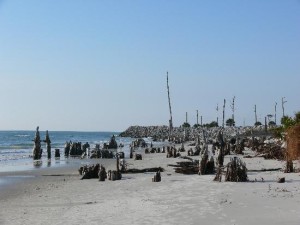

Dr Orrin Pilkey and Dr.Jeff Chanton at Stump Hole
This could be a story about the privilege of co-hosting Duke professor Orrin Pilkey as he toured our barrier island coast last month. I could have relayed his urgent and fascinating take on islands like ours, because Dr. Pilkey has visited most of the 2200 barrier islands on our planet. And you would have been interested in his findings, that almost every single one is thinning on both front and back sides.
“I have come to think of islands as living things,” Pilkey told us. “They have to get skinny in order to migrate. And they have to migrate because of sea level rise.”

Dr. Orrin Pilkey “reading” the signature of the beach
Or: this could be a profile of Dr. Pilkey. The man has written 47 books about the world’s beaches and shores, launched 2000 graduate students, and studied the coastlines of all seven continents. I could have told you how unexpectedly open-hearted and dear—and fearless–was this 82-year-old coastal geologist.

“Brute Force Engineering” and its results
Dr. Philip Froelich had escorted Orrin to Dog and St. George Islands, and also to Alligator Point. Jeff and I were to take the pair in our powerboat around the periphery of St. Vincent Island, but the winds were from the east, and too strong to allow us to safely circumnavigate the Gulf and passes. Instead we went to Cape San Blas: where better to illustrate short-sighted coastal policy decisions then Stump Hole? Orrin shook his head and dubbed the giant rock revetment a great example of “brute force engineering.”
Instead of facing the facts of how our beautiful coast faces inundation as sea level rises, we have to talk about how our visiting dignitary was greeted by our climate-change-denying state administration. Governor Scott’s henchmen at DEP forbade use of the educational Apalachicola National Estuarine Sanctuary for Pilkey’s public lecture.
Nevertheless, a venue was found at a community center in Apalachicola, and powerful truth was spoken about what’s happening to our beaches and why. Under a different administration, and with a willingness to talk about the real challenges facing Florida, a reverent welcome would have been offered to this world renowned authority. That did not happen.
I invite you to read Dr. Pilkey’s editorial in the Tampa Bay Times regarding his experience in our state. I hope you will share it widely!http://www.tampabay.com/opinion/columns/column-the-future-of-floridas-beaches-and-the-publics-right-to-know/2256553
Share On:

Strong post, Sue. Disturbing news. We will all pay a high price for this administration’s greed and denial. Dr. Pilkey sounds like a national treasure!
thanks Susan. Dr. Pilkey speaks the truth.
Susan -I was just there camping at Indian Pass. Enjoyed the magnificent sunset from Stump Hole but appalled at the erosion.
Thanks for the Tampa Bay article.
Michelle Joly
What a shameful act by this Administration but what a thrill to have such a distinguished professor visit us.
John
Thank you so much Sue!